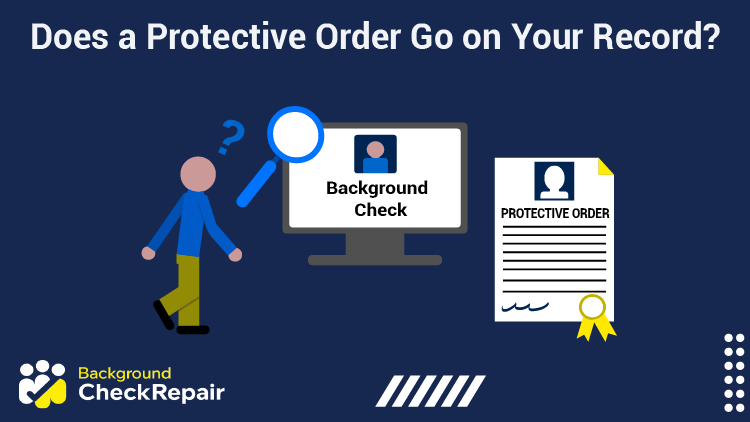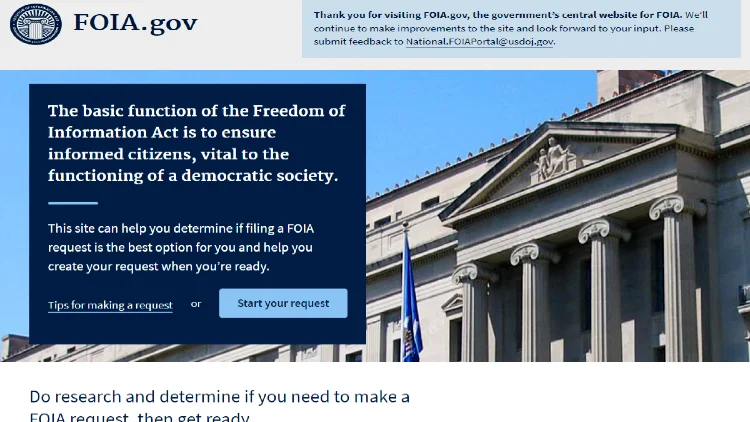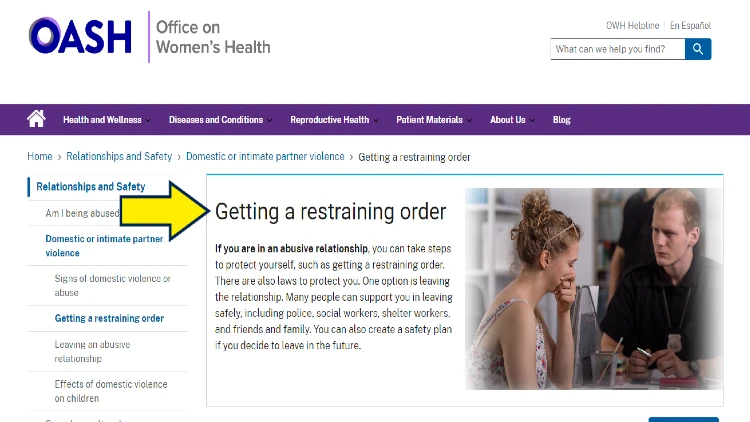What Do I Need To Know on How To Keep Someone Away From You Without a Restraining Order?
A restraining order is the only legal way to keep an individual away from someone in most states
 Written by Background Check Repair
Written by Background Check Repair
Background Checks | June 7, 2024

Table of Contents
Does a protective order go on your record?
There is a lot of confusion surrounding the way protective orders impact an individual’s criminal record, and with protective orders, the answer can be tricky.
In most states, there is no legal distinction between protective orders vs restraining orders and peace orders. All of these terms generally refer to the same thing, a court order that keeps one individual away from another individual.
However, whether or not the order will show up on a background check can depend on a number of circumstances.
So, if an applicant is wondering, does a protective order go on his record, this complete guide outlines when (and in what states) they will, and how to ensure that it doesn’t ruin your chances for employment or residency.
Does a protective order go on your record? The answer will depend on a few different factors. Most notably, the state and applicable state laws regarding protection orders will come into play as each state has slightly different laws and processes regarding obtaining a protection order and what that entails.
Besides state law, the other major factor that will decide what information if any shows up in a criminal record is where and when the order was filed.
Individuals should first understand what a protective order is compared to a restraining order or a peace order. In most states, all of these terms are used interchangeably to refer to the same thing: a judge ordering that one individual stay away from another individual.
In most cases, this is done because there is evidence that suggests that an individual is a danger to another person in some way.
Some states have slightly different legal definitions for a protective order compared to a peace order or restraining order, but they still largely refer to the same thing, the only difference is when each term is used.
For example, some states such as Maryland use the term peace order, to refer to a restraining order that does not involve domestic partners.3
A judge may sign a peace order to prevent a coworker or neighbor from going near another individual.
In other states, the term protective order is used when an individual petition for a restraining order in civil court, whereas restraining order is used to refer to the same order when it is enforced in a criminal court.
However, even in states that make small distinctions between the terms, they are still commonly used interchangeably since they all refer to the same end goal of keeping one individual away from another for purposes of safety.
Although the Freedom of Information Act requires that all court records be publicly available, there are important exceptions to this that will affect protective order records.5
Basically, court documents are considered public because it is generally in the interest of the public to have access to legal proceedings that may affect them.

The Freedom of Information Act allows court documents to be public, and as such, a court order will show up on a person’s record if the order was issued within the time frame allowed by the search.
This is especially true for criminal courts, in which individuals will want to know about any potentially dangerous individuals in their community. However, when it comes to family and civil court, the matter of public interest is a little bit more complicated.
Although it can be easy to see why the public should have access to criminal information, family and civil matters are rarely in the public interest.
Since this information is largely irrelevant to the general public, judges on civil and family cases will often have the records sealed as soon as the case has been completed, in order to protect the families involved and to keep private and personal information from becoming publicly accessible.
When it comes to, will a peace order go on your record, a peace order would go on your record only if it was ordered in criminal court.
Although it is possible for a peace order that was ordered in civil family court to appear on the individual’s record, most of these records are sealed and the vast majority of background checks will only check for records in criminal court databases.
There is a lot of confusion about the way restraining orders affect an individual record, particularly when it comes to temporary restraining orders. So, does a temporary restraining order remain on your record, in most cases it is highly unlikely to appear on an individual’s criminal record.
Much of this confusion comes from misconceptions regarding temporary restraining orders. Most restraining orders are filed in civil court by an individual, the petitioner, who feels threatened by another individual and wants legal protection so that the individual can not come near them or contact them.
To do this, the petitioner files for a temporary restraining order with a civil court. In most cases, a judge will hear the case on the same day of the filing and will usually listen to testimony from the petitioner and their legal counsel.
The defendant does not need to be present during this hearing. Should the petitioner convince the judge that this individual poses an imminent threat, the judge will sign a temporary restraining order.
A temporary restraining order grants the same protections as a normal restraining order, most often forbidding the defendant from having any contact with the individual including in person or electronically, most often for 14 days or until the next court date.
The next court date will be the hearing for a permanent restraining order, in which both the petitioner and the defendant will need to be present to plead their case before a judge.
With all that being said, a temporary restraining order usually comes as a result of a civil court restraining order case. This means that it is unlikely for a temporary restraining order to appear on the individual’s record unless civil court databases are checked and the records were not sealed by the judge.
When it comes to how long a restraining order remains on your record, state law will be the biggest factor to consider. As mentioned, civil and family court cases will rarely appear on an individual’s record, regardless of what state the case was heard in.
However, when it comes to criminal court cases, including those involving a protective order, state laws regarding criminal history will come into play.2
Per the FCRA, there are no limits on how far back a background check can go when examining criminal history information at the federal level.7 However, a handful of states have adopted their own laws that prevent criminal history information from appearing on a background check if it is older than 7 years or 10 years, in certain circumstances.
This means that a restraining order that was filed in criminal court will likely appear on an individual’s record for at least 7 years, and possibly forever. It’s important to note that even for individuals who live in 7-year-states, these laws only protect criminal history information from being accessible to the public.
The records themselves will still exist and can be accessed by the individual themselves, as well as official agencies.
This means that if an individual is applying for a federal job, there are background check disqualifiers for federal employment, which will generally require they pass an FBI background check, then subsequent FBI Identity History Summary Check will be able to view information regarding the restraining order.1
When in doubt, performing a restraining order background check might be the best way to find out what kind of information is present on your record.
Individuals can use the search bar at the top of this page to perform a background check on themselves. Simply enter the name of the individual you wish to check to perform a public records search.
Individuals can also use other online background check services, such as those that offer 7 day free trial to perform a background check on themselves. There is also the option to perform a more thorough way on how to obtain a federal background check on yourself to get the best results possible.
Many individuals who are in a dangerous situation might want to know how to file a restraining order, even individuals who are not completely sure that this is the right option should still know the basic steps just in case.4

Obtaining restraining orders is simplified by the Office on Women’s Health, which is a public website that can help women in abusive relationships.
Filing a restraining order will have a slightly different process in every state, however, it will always be easier with the help of an attorney. Individuals who do not have this option will still be able to file a restraining order in civil court themselves.
Most states will have a form available, such as the civil protection order form in Colorado, which allows individuals to fill in their information and get the process started.9 Many states allow individuals to fill out and submit these forms electronically.
Once the initial form has been submitted to the proper courts, hearings are usually scheduled on the same day. During this hearing, the petitioner will be able to explain their case to a judge who will grant a temporary restraining order if it is clear the petitioner faces an imminent threat.8
Once the TRO has been signed, a court date will be set for the full hearing.
There are several different types of restraining orders in each state. In most cases, these will all come down to two different kinds of orders that will be used for various circumstances: a temporary order OR a permanent restraining order.
Temporary restraining orders are used to protect individuals who are in danger, at least until a court date is set and the judge can hear all the facts of the case to decide if a permanent restraining order is warranted or not.
A permanent restraining order will come as a result of the main hearing if the judge decides the individual poses a risk to the safety of the petitioner. Laws vary from state to state but most permanent restraining orders will last a set amount of time, usually around 5 years.
After the time has expired, the individual can petition to have the order reinstated.
When it comes to what type of proof I need to support a restraining order, the main thing that individuals are trying to prove is that a specific individual poses a threat to their safety. In most cases, this will involve a domestic partner so the evidence will vary widely based on the unique situation.
This is one of the reasons that having a lawyer in this situation is so important as they will be able to examine the facts and evidence of the case and help decide which pieces of evidence will be the most effective in convincing the judge.
However, threatening text messages or other evidence of domestic abuse or the intent to commit domestic abuse are the basic evidence that individuals should be looking for.
In regards to what to say in court for a restraining order, individuals should focus on evidence that demonstrates that the individual in question intends to harm them in some way, or that they have demonstrated a pattern of abuse.
As far as how to win a restraining order hearing, the answer is extremely complicated. As with any court case, there is no surefire way to win. Contacting a lawyer and taking their advice will give individuals their best chances.
Restraining orders can be fairly complicated and many individuals will have unique questions specific to their situation.
Keep in mind that the way restraining and protective orders work varies from state to state so it is important that individuals familiarize themselves with their state laws or contact an attorney for legal counsel.
A common question about restraining orders is if someone has a restraining order on you, can they contact you, the answer to this will vary from case to case. In most restraining order or protective order cases, the individual will not be able to contact the individual in any way or come within a certain distance of the individual.
This extends to all forms of communication and the distance limit usually involves not just the individual themselves, but their school, work, and home.
When it comes to how long a restraining order stays on your record in California, the answer is actually quite simple. If the restraining order came as a result of a civil case it will not appear on the individual’s record in most cases.
In the event of the order coming from a criminal court case, the order will be on the individual’s record for seven years. The key exception to this is if an official agency is examining the individual’s record, in which case there will be no time restraints and the criminal record will always be present.
Another common question is, how does a restraining order work if you live in the same house, however, the answer will depend on the nature of the order. If it is a traditional order, one of the individuals will need to vacate the home in most cases.
When it comes to whether can you lose your job if you have a restraining order, the answer is usually no. Although employers may have their own policies regarding criminal records, most restraining orders are not criminal issues and the employer will have no way of knowing the order exists unless it affects the individual’s work.
Issues involving, what happens if a restraining order is not served, happen fairly rarely. It is fairly uncommon for the sheriff to be unable to serve an individual their order, however, when it happens the judge will usually extend the time period and they will continue to try and serve the order to the individual.
When it comes to, does a restraining order remain on your record forever, it will depend on the circumstances. Since the majority of states do not have limits on how long criminal history is available, then restraining orders that were filed in criminal court will often stay on record forever.
As far as whether restraining orders show up on background checks, is concerned, the answer will depend on what court the order was filed in. Most background checks only involve checks of criminal court records so orders filed in family court will rarely show up.
Those wondering how to get a restraining order off your record will need to go through the process of having the record sealed. This will be fairly easy for a civil case, but how to remove a criminal record from a background check or get criminal records sealed or expunged is notoriously difficult.
It is important to keep track of restraining order dates so individuals can have them reinstated as soon as they expire.
Keep in mind that contact after a restraining order expires is completely legal in most cases.
Individuals wondering how I know when my restraining order expires should be able to find the necessary information in the documents from the initial hearing regarding the order.
Since restraining orders don’t last forever, many people will be wondering how difficult it is to renew a restraining order, the answer is that it is about as difficult as filing the initial order.
The same rules will apply and the individual will need to prove that the other individual still poses a threat.
There can be a lot to consider when it comes to does a protective order goes on your record. The simple answer is that if it was ordered in criminal court, it is likely on your record.
Individuals should always run a background check on themselves to be sure.
What this means for protective orders is that most of the restraining orders or protective orders that are filed in civil and family courts will be sealed upon filing. Although these records would normally be public, they will instead only be accessible to the individuals involved in the case and thus will not appear on the individual’s record in most cases.
However, some restraining orders, particularly those that involve domestic abuse of some kind are filed in criminal court, rather than family or civil court.6 Restraining or protective orders that are filed in criminal court will appear on the individual’s record and be present on most background checks.
So, does a protective order go on your record, the answer is yes if it was filed in a criminal court.
A restraining order is the only legal way to keep an individual away from someone in most states
Restraining orders filed in criminal court will appear on the individual’s record.
When a restraining order expires all protection orders are vacated and the individual is legally able to contact the petitioner.
Restraining orders can be dismissed if there is no evidence that the petitioner is in danger or if the petitioner wishes to initiate contact with the defendant.
Individuals can look up restraining orders online via court documents where the order was filed.
Individuals will be given the option to renew an order after it expires, but they will need to prove they are still in danger.
When a restraining order expires the petitioner can file for another order if they believe they are still in danger.
Most domestic violence restraining orders are filed in criminal court and thus will appear on a background check
Generally, protective orders will stay on your records for a limited period of time and won’t show up on criminal background checks as these orders are civil in nature. However, when the order is violated or is put out in relation to criminal charges then the order could possibly go on an individual’s record forever.
1Federal Bureau of Investigation. (2022). Identity History Summary Checks (Rap Sheets). FBI. Retrieved December 7, 2022, from <https://www.fbi.gov/how-we-can-help-you/more-fbi-services-and-information/identity-history-summary-checks>
2Kuperman, A. (2010, July). Case Law on Entering Protective Orders, Entering Sealing Orders, and Modifying Protective Orders. United States Courts. Retrieved December 7, 2022, from <https://www.uscourts.gov/sites/default/files/caselaw_study_of_discovery_protective_orders_1.pdf>
3Maryland Judiciary. (2022). Domestic Violence – Peace Orders. Maryland Courts. Retrieved December 7, 2022, from <https://mdcourts.gov/legalhelp/peaceorders>
4US Department of Health and Human Services. (2021, February 15). Getting a restraining order. Office on Women’s Health. Retrieved December 7, 2022, from <https://www.womenshealth.gov/relationships-and-safety/domestic-violence/getting-restraining-order>
5US Department of Justice. (2022). Freedom of Information Act. FOIA.gov. Retrieved December 7, 2022, from <https://www.foia.gov/>
6US Government. (2022). Domestic Violence. The United States Department of Justice. Retrieved December 8, 2022, from <https://www.justice.gov/ovw/domestic-violence>
7US Government. (2022). Fair Credit Reporting Act. Federal Trade Commission. Retrieved December 7, 2022, from <https://www.ftc.gov/legal-library/browse/statutes/fair-credit-reporting-act>
8US Government. (2022). Injunctions/Temporary Restraining Orders. US Marshals Service. Retrieved December 7, 2022, from <https://www.usmarshals.gov/what-we-do/service-of-process/civil-process/injunctions-temporary-restraining-orders>
9US Government. (2022). Instructions for Obtaining a Civil Protection Order. Colorado Judicial Branch. Retrieved December 7, 2022, from <https://www.courts.state.co.us/Forms/PDF/JDF%20572%20%20-%20Instructions%20for%20Extreme%20Risk%20Protection%20Order.pdf>
We use cookies to ensure that we give you the best experience on our website. If you continue to use this site we will assume that you are happy with it